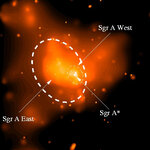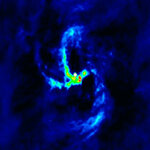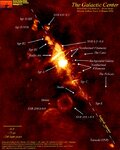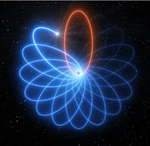Virtually all massive galaxies, including our own, host central black holes ranging in mass from millions to billions of solar masses. The growth of these black holes releases vast amounts of energy that powers quasars and other weaker active galactic nuclei. A tiny fraction of this energy, if absorbed by the host galaxy, could halt star formation by heating and ejecting ambient gas. A central question in galaxy evolution is the degree to which this process has caused the decline of star formation in large elliptical galaxies, which typically have little cold gas and few young stars, unlike spiral galaxies.
Galaxies come in two basic types: ̳football-shaped‘ ellipticals and ̳disk-shaped‘ spirals. Spirals contain plenty of cold gas, which forms stars, whereas the gas in ellipticals is too hot to form stars. Thus, ellipticals lack the young blue stars that are usually seen in spirals, and are generally quite red. Spirals also have central bulges structurally resembling miniature ellipticals. Owing to this similarity, we use the term ̳bulges‘ for bulges within spirals and for ellipticals indiscriminately.
The strongest evidence for black hole feedback is in galaxy clusters, but we still lack a sufficient understanding of the processes that transfer energy from AGN* to the surrounding gas and thermalize the hydrodynamic disturbances excited by expanding jets and raising bubbles. Standard viscosity, turbulent viscosity, the stretching and tearing of magnetic field lines, and cosmic rays could all contribute to heat and/or lift the intracluster medium. The statement that black holes self-regulate to the accretion rate that is required to offset cooling is a valid first approximation, but some gas does cool and flow onto the central galaxies of clusters, although at a very low rate compared to predictions for pure cooling flow models.
The interaction of radio galaxies with their own interstellar media is much less clear than the interaction with the intracluster medium. In the case of radiative feedback, the basic physics of the interaction with the interstellar medium are much better understood. The main open problem is rather whether radiative feedback can deliver the energy required for the ̳maintenance‘ of individual ellipticals without exceeding the observational limits on the fraction containing an AGN.
The greatest uncertainty is the role of quasar winds in quenching star formation. This is because the masses of the winds detected spectroscopically are uncertain by more than one order of magnitude. Improving the current estimates for the masses, length scales, and temperature structure of the winds at all redshifts is the critical observational challenge. There is a greater need to better understand the properties of galaxies in transition from the blue to the red population.
It is advanced computer simulations that indicate the need for quasar quenching, but these simulations are based on uncertain models for star formation and the physics of the interstellar medium. Progress in our understanding of these processes and higher resolutiosimulations will be necessary before we can conclude that quasar feedback is in fact needed, particularly in lower-mass ellipticals where the decline of the star formation rate occurs on a longer timescale.
See: https://arxiv.org/pdf/0907.1608.pdf
* AGN - Active Galactic Nuclei are the most powerful, long-lived objects in the Universe. Recent data confirm the theoretical idea that the power source is accretion into a massive black hole. The common occurrence of obscuration and outflows probably means that the contribution of active galactic nuclei to the power density of the Universe has been generally underestimated.
Active galactic nuclei (AGN) involve the most powerful, steady sources of luminosity in the Universe. They range from the nuclei of some nearby galaxies emitting about 1040 erg⋅s−1(1 erg = 0.1 μJ) to distant quasars emitting more than 1047 erg⋅s−1. The emission is spread widely across the electromagnetic spectrum, often peaking in the UV, but with significant luminosity in the x-ray and infrared bands. It is spatially unresolved except in the radio band, where there is sometimes evidence for collimated outflows at relativistic speeds. The power output of AGN is often variable on time scales of years and sometimes on time scales of days, hours, or even minutes.
Causality implies that an object that varies rapidly in time t must be smaller than the light-crossing time of the object, ct (where c is the speed of light) and thus must be spatially small; if not, the variation would appear smoothed. High luminosities imply high masses such that gravity can combat radiation pressure, which would otherwise blow the object apart (that is, the luminosity must be less than the Eddington limit). AGN therefore are of very high mass density, and it has long been assumed that they consist of a massive black hole, of say 108 solar masses (M⊙) or more, accreting the gas and dust at the center of a galaxy. The gravitational energy liberated during accretion onto a black hole is ≈10% of the rest mass energy of that matter and is the most efficient mass–energy conversion process known involving normal matter (that is, ignoring the use of antimatter; nuclear burning releases at most 0.7% of the mass-energy). Indeed, the rapid variations seen in some powerful AGN argue for some high efficiency process, more efficient than nuclear burning.
The accreting matter probably has some angular momentum, which causes it to orbit the black hole and, through dissipation of energy, flatten to form a disk within which magnetic viscosity transfers the angular momentum outward and the mass inward. Unless the accretion rate is either high or very low, it is likely that the gravitational energy liberated is radiated locally, much of it as thermal radiation from the surface of the disk, peaking in the UV as expected. Some energy, however, is probably stored temporarily in magnetic fields before being released in flares, which make the x-ray emission particularly variable.
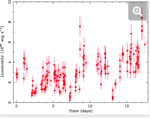
X-ray lightcurve of the powerful, radio-quiet Active Galactic Nucleus PHL1092. Note the persistent large variability. A remarkable flare on day 8 shows a change in luminosity exceeding 10*42 erg⋅s−2. This requires a mass-to-energy conversion efficiency exceeding 0.6 and cannot be associated with stellar processes. Mildly relativistic motions close to a black hole have probably amplified the apparent variability.
AGN have been classified in many ways. Three important classes are: (i) the Seyfert galaxies, which have modest luminosities but tend to be the best studied since they generally lie near to us; (ii) the quasars, which are more luminous than the host galaxy and are particularly numerous at a redshift of ≈2, when the Universe was about one third its present age; and (iii) the blazars. About 10% of quasars are radio-loud; the rest are radio-quiet, although not silent. Radio loudness is generally associated either directly with a collimated relativistic outflow or jet or with regions where a jet has collided with surrounding material. A blazar is seen when our line of sight lies close to the direction of a jet.
An important issue is the obscuration of AGN by dust and gas along the line of sight, which can change or hide the spectrum of an AGN. Seyferts have long been divided into types I and II, in which the second type clearly are obscured versions of the first type (in some, the characteristic broad optical lines of type I are seen in the polarized, scattered component of type II). There are several unification schemes where the classification of an object depends on its orientation. The local number density of Seyfert II galaxies is several times that of Seyfert I galaxies. What is not yet clear is whether quasars can or should be similarly divided. There are no good examples of a type II quasar, although there are many obscured powerful objects that may host accreting black holes, such as the ultraluminous infrared galaxies.
One strong indication that much of the accretion in the Universe is obscured, whatever the name of the objects, is the x-ray background. The spectrum of this background radiation is harder than that of any unobscured objects, and it can only be successfully explained by synthesizing it from objects that are strongly absorbed, that is, surrounded by absorbing gas or dust. A simple global analysis of its spectrum then suggests that as much as 85% of the accretion power in the Universe may be absorbed and reradiated at longer wavelengths (mostly in the infrared).
The evolution of quasars is fairly well understood from numerous optical and other surveys. Most nearby galaxies probably hosted a quasar at or near their center in the past. Indeed, estimates of the mass accreted into black holes required to explain quasar counts and the x-ray background are in rough agreement with the local space density of massive black holes. Quasar activity peaked roughly when star formation activity associated with galaxy formation peaked, and it is of course likely that these processes are related (3). Both require an abundance of gas in deep gravitational potential wells.
Whether Seyfert galaxies are the endpoint of powerful quasars is doubtful, given that many quasars, both radio-loud and radio-quiet, lie in elliptical galaxies, whereas many Seyferts are in spiral galaxies, the latter of which are typically less massive and younger than the former.
See: https://www.pnas.org/content/96/9/4749
While not overly mathematical, I think this article on black holes and galaxy formation will illuminate how they impact both spiral and elliptical galaxies. I found the impacts of active galactic nuclei particularly deleterious and it has a profound effect on the central interstellar medium by blasting it away and eliminating its star forming potential. I urge those similarly curious to read the articles attached here.
Hartmann352
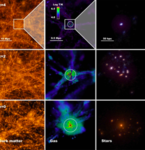
A computer simulation of the formation of an elliptical galaxy. The nine panels illustrate the formation of an elliptical galaxy by showing how the dark matter (left column), the gas (centre column) and the stars (right column) are distributed at three epochs in the expansion of the Universe: when the Universe was 1/5 of its current size (redshift z = 4), when the Universe was 1/3 of its current size (z = 2), and today (z = 0). The gravity of the dark matter dominates the evolution on large scales (left column). As time passes, the Universe becomes lumpier because the dark matter clumps via gravity into haloes (bright orange spots in the left panels). The centre column zooms into the region around and inside a halo to show what happens to the gas. The halo radius is shown as a white circle, and the gas is colour-coded according to its temperature: blue is cold, green (and red) is hot. Initially the halo is small, and the gas streams into the halo down to its centre in cold flows. When the halo reaches the critical mass Mcrit ≈ 1012M (z = 2), the gas begins to form a hot atmosphere (green); eventually, all the gas within the halo is hot (z = 0). The right column zooms in even further to show the visible galaxy formed by the gas fallen to the centre. The galaxy is initially a blue spiral (z = 4). It starts to become red when the halo gas starts to be hot (z = 2). By then, its halo has merged with neighbouring haloes to form a galaxy group. Mergers with companions eventually transform the galaxy into an elliptical (z = 0).
Galaxies come in two basic types: ̳football-shaped‘ ellipticals and ̳disk-shaped‘ spirals. Spirals contain plenty of cold gas, which forms stars, whereas the gas in ellipticals is too hot to form stars. Thus, ellipticals lack the young blue stars that are usually seen in spirals, and are generally quite red. Spirals also have central bulges structurally resembling miniature ellipticals. Owing to this similarity, we use the term ̳bulges‘ for bulges within spirals and for ellipticals indiscriminately.
The strongest evidence for black hole feedback is in galaxy clusters, but we still lack a sufficient understanding of the processes that transfer energy from AGN* to the surrounding gas and thermalize the hydrodynamic disturbances excited by expanding jets and raising bubbles. Standard viscosity, turbulent viscosity, the stretching and tearing of magnetic field lines, and cosmic rays could all contribute to heat and/or lift the intracluster medium. The statement that black holes self-regulate to the accretion rate that is required to offset cooling is a valid first approximation, but some gas does cool and flow onto the central galaxies of clusters, although at a very low rate compared to predictions for pure cooling flow models.
The interaction of radio galaxies with their own interstellar media is much less clear than the interaction with the intracluster medium. In the case of radiative feedback, the basic physics of the interaction with the interstellar medium are much better understood. The main open problem is rather whether radiative feedback can deliver the energy required for the ̳maintenance‘ of individual ellipticals without exceeding the observational limits on the fraction containing an AGN.
The greatest uncertainty is the role of quasar winds in quenching star formation. This is because the masses of the winds detected spectroscopically are uncertain by more than one order of magnitude. Improving the current estimates for the masses, length scales, and temperature structure of the winds at all redshifts is the critical observational challenge. There is a greater need to better understand the properties of galaxies in transition from the blue to the red population.
It is advanced computer simulations that indicate the need for quasar quenching, but these simulations are based on uncertain models for star formation and the physics of the interstellar medium. Progress in our understanding of these processes and higher resolutiosimulations will be necessary before we can conclude that quasar feedback is in fact needed, particularly in lower-mass ellipticals where the decline of the star formation rate occurs on a longer timescale.
See: https://arxiv.org/pdf/0907.1608.pdf
* AGN - Active Galactic Nuclei are the most powerful, long-lived objects in the Universe. Recent data confirm the theoretical idea that the power source is accretion into a massive black hole. The common occurrence of obscuration and outflows probably means that the contribution of active galactic nuclei to the power density of the Universe has been generally underestimated.
Active galactic nuclei (AGN) involve the most powerful, steady sources of luminosity in the Universe. They range from the nuclei of some nearby galaxies emitting about 1040 erg⋅s−1(1 erg = 0.1 μJ) to distant quasars emitting more than 1047 erg⋅s−1. The emission is spread widely across the electromagnetic spectrum, often peaking in the UV, but with significant luminosity in the x-ray and infrared bands. It is spatially unresolved except in the radio band, where there is sometimes evidence for collimated outflows at relativistic speeds. The power output of AGN is often variable on time scales of years and sometimes on time scales of days, hours, or even minutes.
Causality implies that an object that varies rapidly in time t must be smaller than the light-crossing time of the object, ct (where c is the speed of light) and thus must be spatially small; if not, the variation would appear smoothed. High luminosities imply high masses such that gravity can combat radiation pressure, which would otherwise blow the object apart (that is, the luminosity must be less than the Eddington limit). AGN therefore are of very high mass density, and it has long been assumed that they consist of a massive black hole, of say 108 solar masses (M⊙) or more, accreting the gas and dust at the center of a galaxy. The gravitational energy liberated during accretion onto a black hole is ≈10% of the rest mass energy of that matter and is the most efficient mass–energy conversion process known involving normal matter (that is, ignoring the use of antimatter; nuclear burning releases at most 0.7% of the mass-energy). Indeed, the rapid variations seen in some powerful AGN argue for some high efficiency process, more efficient than nuclear burning.
The accreting matter probably has some angular momentum, which causes it to orbit the black hole and, through dissipation of energy, flatten to form a disk within which magnetic viscosity transfers the angular momentum outward and the mass inward. Unless the accretion rate is either high or very low, it is likely that the gravitational energy liberated is radiated locally, much of it as thermal radiation from the surface of the disk, peaking in the UV as expected. Some energy, however, is probably stored temporarily in magnetic fields before being released in flares, which make the x-ray emission particularly variable.

X-ray lightcurve of the powerful, radio-quiet Active Galactic Nucleus PHL1092. Note the persistent large variability. A remarkable flare on day 8 shows a change in luminosity exceeding 10*42 erg⋅s−2. This requires a mass-to-energy conversion efficiency exceeding 0.6 and cannot be associated with stellar processes. Mildly relativistic motions close to a black hole have probably amplified the apparent variability.
AGN have been classified in many ways. Three important classes are: (i) the Seyfert galaxies, which have modest luminosities but tend to be the best studied since they generally lie near to us; (ii) the quasars, which are more luminous than the host galaxy and are particularly numerous at a redshift of ≈2, when the Universe was about one third its present age; and (iii) the blazars. About 10% of quasars are radio-loud; the rest are radio-quiet, although not silent. Radio loudness is generally associated either directly with a collimated relativistic outflow or jet or with regions where a jet has collided with surrounding material. A blazar is seen when our line of sight lies close to the direction of a jet.
An important issue is the obscuration of AGN by dust and gas along the line of sight, which can change or hide the spectrum of an AGN. Seyferts have long been divided into types I and II, in which the second type clearly are obscured versions of the first type (in some, the characteristic broad optical lines of type I are seen in the polarized, scattered component of type II). There are several unification schemes where the classification of an object depends on its orientation. The local number density of Seyfert II galaxies is several times that of Seyfert I galaxies. What is not yet clear is whether quasars can or should be similarly divided. There are no good examples of a type II quasar, although there are many obscured powerful objects that may host accreting black holes, such as the ultraluminous infrared galaxies.
One strong indication that much of the accretion in the Universe is obscured, whatever the name of the objects, is the x-ray background. The spectrum of this background radiation is harder than that of any unobscured objects, and it can only be successfully explained by synthesizing it from objects that are strongly absorbed, that is, surrounded by absorbing gas or dust. A simple global analysis of its spectrum then suggests that as much as 85% of the accretion power in the Universe may be absorbed and reradiated at longer wavelengths (mostly in the infrared).
The evolution of quasars is fairly well understood from numerous optical and other surveys. Most nearby galaxies probably hosted a quasar at or near their center in the past. Indeed, estimates of the mass accreted into black holes required to explain quasar counts and the x-ray background are in rough agreement with the local space density of massive black holes. Quasar activity peaked roughly when star formation activity associated with galaxy formation peaked, and it is of course likely that these processes are related (3). Both require an abundance of gas in deep gravitational potential wells.
Whether Seyfert galaxies are the endpoint of powerful quasars is doubtful, given that many quasars, both radio-loud and radio-quiet, lie in elliptical galaxies, whereas many Seyferts are in spiral galaxies, the latter of which are typically less massive and younger than the former.
See: https://www.pnas.org/content/96/9/4749
While not overly mathematical, I think this article on black holes and galaxy formation will illuminate how they impact both spiral and elliptical galaxies. I found the impacts of active galactic nuclei particularly deleterious and it has a profound effect on the central interstellar medium by blasting it away and eliminating its star forming potential. I urge those similarly curious to read the articles attached here.
Hartmann352

A computer simulation of the formation of an elliptical galaxy. The nine panels illustrate the formation of an elliptical galaxy by showing how the dark matter (left column), the gas (centre column) and the stars (right column) are distributed at three epochs in the expansion of the Universe: when the Universe was 1/5 of its current size (redshift z = 4), when the Universe was 1/3 of its current size (z = 2), and today (z = 0). The gravity of the dark matter dominates the evolution on large scales (left column). As time passes, the Universe becomes lumpier because the dark matter clumps via gravity into haloes (bright orange spots in the left panels). The centre column zooms into the region around and inside a halo to show what happens to the gas. The halo radius is shown as a white circle, and the gas is colour-coded according to its temperature: blue is cold, green (and red) is hot. Initially the halo is small, and the gas streams into the halo down to its centre in cold flows. When the halo reaches the critical mass Mcrit ≈ 1012M (z = 2), the gas begins to form a hot atmosphere (green); eventually, all the gas within the halo is hot (z = 0). The right column zooms in even further to show the visible galaxy formed by the gas fallen to the centre. The galaxy is initially a blue spiral (z = 4). It starts to become red when the halo gas starts to be hot (z = 2). By then, its halo has merged with neighbouring haloes to form a galaxy group. Mergers with companions eventually transform the galaxy into an elliptical (z = 0).
Last edited:

